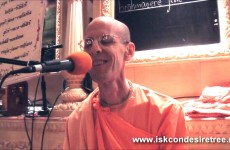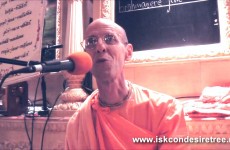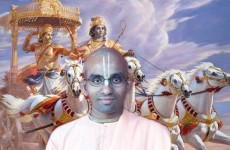Question: What is difference between Goloka and Vaikuntha?
And on what basis is it decided that a soul will go to Vaikuntha or Goloka?
Answer: These are two separate but related questions so we will answer them together.
Go means cow and loka means abode.
So Goloka is the spiritual abode of the cows where Shyamasundara Krishna is eternally engaged in His pastimes with the cows, cowherd men and cowherd women.
Vai is a modified prefix (upasarga) which has a sense of negation and kuntha means anxiety.
So Vaikuntha is place without anxieties.
Vaikuntha has several Vaikuntha planets – each presided by Narayana the Lord of Vaikuntha.
Both Vaikuntha and Goloka are beyond the material realms and essentially spiritual.
This much is common.
However there are three main differences –
1) The Lord of Goloka is Krishna and the Lord of Vaikuntha is Narayana
2) The inhabitants of Vaikuntha have a different spiritual sentiment or rasa compared to the inhabitants of Goloka. 3)The bliss (ananda) one experiences in Goloka is much more than the bliss in Vaikuntha.
It is mentioned in the Brahma Samhita:
goloka-namni nija-dhamni tale ca tasya
devi mahesa-hari-dhamasu tesu tesu
te te prabhava-nicaya vihitas ca yena
govindam adi-purusam tam aham bhajami
“I adore the primeval Lord Govinda, who resides in His personal abode named Goloka, below which are the respective realms of Maya Devi, Lord Shiva and the Lord of Vaikuntha, Narayan. Lord Govinda alone allots each of these abodes and their presiding deities with their particular powers”. (Brahma Samhita 5.47)
In fact there are six divisions in the spiritual sky:
Goloka Vrindavana, Navadvipa, Mathura, Dvaraka, Ayodhya and Vaikuntha – with the highest bliss found in Goloka.
As Srila Bhaktisiddhanta Saraswati Thakura puts it in Sri Sajjana Tosani, Interview with Professor Johans – Head of the Department of Philosophy, St. Xaviers College:
“The bliss available in Ayodhya is better than that in Vaikuntha; the bliss in Dwaraka is superior to that in Ayodhya; and the bliss of the denizens of Goloka is the climax of all bliss.
The difference in the degree of a particular Rasa or sentimental mellowness is the cause of the difference in the degree of the bliss.
Even the afflictions and distresses that may be there in Goloka dance on the crest of all forms of blisses and happinesses; these are rather nourishers of the highest form of bliss.”
The superiority of bliss available in Goloka is also demonstrated in the exchange between Lord Caitanya and Vyenkata Bhatta where we learn that even Laksmidevi – the eternal consort of Narayana hankers to enter the rasa dance in Goloka. (Cc Madhya 9.111-138)
The intensity of attraction and affection one possesses towards Krishna determines the abode where a living entity would reach.
Krishna reciprocates in proportion to ones desires by facilitating the devotees existence in an abode where the devotee is able to serve the Lord in his or her predominant mood.
This is confirmed in the Bhagavad Gita (9.6) with the words – ye yatha mam prapadyante, tams tathaiva bhajamy aham.
If a soul reveres Krishna as his Lord and King and desires to become His servant then he may serve in Dvaraka.
If a soul wants to lovingly serve Lord Ramachandra then he may serve in Ayodhya.
If a soul has spontaneous, unalloyed devotion towards Krishna as his child then he may serve in Goloka as Krishna’s Uncle or Aunt or a senior gopa or gopi.
The practitioners of spontaneous, loving, pure devotional service to Krishna (raganuga-bhaktas) reach Krishna’s abode of Goloka.
Whereas those who practice devotional service following strict regulative principles (vaidhi-bhaktas) reach Vaikuntha or other spiritual planets.
Categorising in terms of what spiritual sentiments (rasas) exist in Vaikuntha and Goloka one can understand that in Vaikuntha planets Lord Narayana can be worshiped with only two-and-half rasas or spiritual sentiments namely, santa (neutral), dasya (servitorship), and half sakhya (friendship).
This half sakhya (friendship) of Vaikuntha takes the shape of formal respectful friendship.
Beyond Vaikuntha lies Goloka where the embodiment of all rasas resides; the twelve rasas being : five principal rasas namely, santa (neutral), dasya (servitorship), sakhya (friendship), vatsalya (parental) and madhurya (conjugal); and seven subsidiary rasas namely, hasya (humourous), adbhuta (wonderment), karuna (pity), raudra (anger), vira (chivalry), bhayanaka (fearsome), vibhatsa (horror).
Lord Krishna is worshipped by all the twelve rasas.
[For more details, visit – www.harekrishnatube.com]

















































































